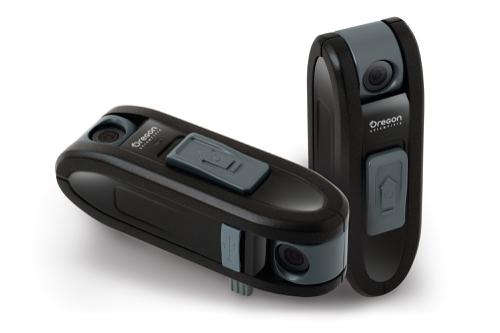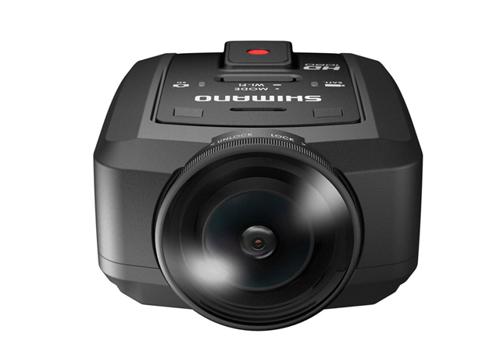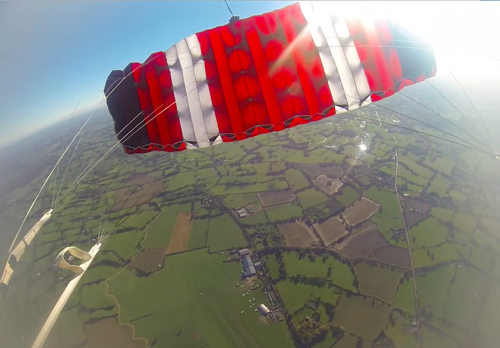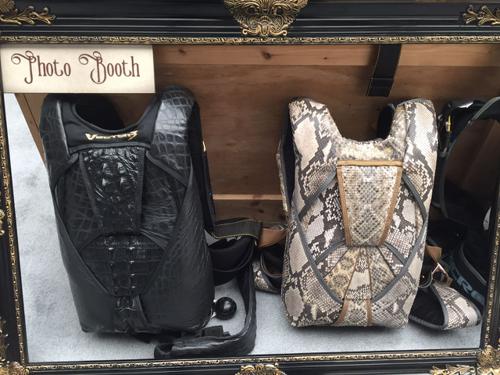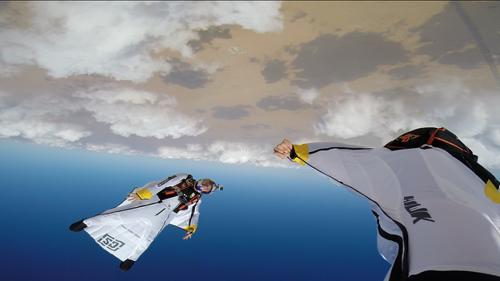Know your gear series: Harness, fitting to your body and effects to consider.
by Damian Alvarez
The harness is a fundamental piece of your skydiving gear. As such, you know it like the back of your hand, right? Maybe the answer is "well, not really". Many experience jumpers will answer that. Most novice jumpers looking for their first rig also often neglect the importance of a harness that fits them. Coming from "one size fits nobody" student gear, they don't even know how a harness should fit them. This might change once they order their first custom harness/container system, if they ever do. If you want to know your gear a bit better, or if you want to inform yourself a bit better about what you should look for when buying a harness/container, either new or second hand, then this article is for you.
What is a Skydiving Harness?
The harness is the part of your harness/container system that is designed to keep your body attached to your canopies. In today's sport skydiving gear, the harness and container are 2 different but inseparable pieces. It wasn't always like that. In the 60s and early 70s harnesses and containers were interchangeable. That allowed to quickly swap components as needed. While this might seem like a good idea at first, these systems had their own set of problems. They were heavy due to the additional hardware needed, and error prone, as they had more room for assembling errors. In the 70s manufacturers started to integrate both into a single harness/container system, hiding part of the harness in the backpad of the container. This concept stays with us almost 50 years later.
Even though the harness and container are today a single unit, it is important to know that the container is built around canopy sizes, and the harness is built around body dimensions. A byproduct of these two pieces of gear being inseparable, is that rookies typically focus on a single thing: the range of canopies they can fit in the container. That is not an issue when they are buying a custom harness/container (as long as the body measurements provided to the manufacturer are accurate), but novice jumpers start their skydiving career typically by buying used gear. Take a look at your DZ next time you are there, and pay close attention to how different harnesses fit their owners. I bet you'll find a few ill-fitting harnesses among new jumpers. Later on we'll see why this is important. But first, we have to know a bit more about the harness itself.
Basic Harness Components and Construction
Before getting into the details of harness construction, it makes sense to take a look at the webbing and tape types used for it. Distinguishing webbing and tape is not obvious. Generally it is considered webbing anything wider than 1" and with a tensile strength higher than 1000 lbs, and tape anything less than any of these 2 parameters. The table summarizes the most common webbing and tape types in harness construction. The pictures below show how they look like and how to distinguish them.
Common webbings and tapes used in harnesses.
Kind
Type
Tensile strength
Width
Common use
Webbing
Type 7
6000 lbs (2721 kg)
1 23/32" (4.3 cm)
MLW, laterals and risers
Type 8
4000 lbs (1814 kg)
1 23/32" (4.3 cm)
Risers and straps
Type 12
1200 lbs (544 kg)
1 23/32" (4.3 cm)
Reinforcement around rings
Type 13
7000 lbs (3175 kg)
1 23/32" (4.3 cm)
MLW and straps
Type 17
2500 lbs (1134 kg)
1" (2.5 cm)
Chest straps, main risers
3" Type 4
1800 lbs (816 kg)
3" (7.6 cm)
Confluence wraps
Tape
Type 4-B
1000 lbs (453 kg)
1" (2.5 cm)
Reinforcement around rings and confluence wraps
Type 7 webbing. Has yellow lines at the edge. Photo: Bally Ribbon Mills
Type 8 webbing. Has a black centerline. Photo: Bally Ribbon Mills
Type 12 webbing. Has red lines at the edge. Photo: Bally Ribbon Mills
Type 13 webbing. Has black lines at the edge. Photo: Bally Ribbon Mills
Type 17 webbing. Photo: Bally Ribbon Mills
3" Type 4 webbing (Spec. PIA-W-4088). Do not confuse with Type 4 tape. Some authors consider this as tape, not webbing, due to the low tensile strength it has (relative to its width). Photo: Bally Ribbon Mills
Type 4-B tape (Spec. PIA-T-5038). Do not confuse with 3" Type 4 webbing. Photo: Bally Ribbon Mills
Now, you can try and take a look at your harness. Can you identify the different types of webbing and tapes used on it? If you do take a look, you'll also notice that in most parts of the harness you have actually two layers of webbing instead of one. There are two reasons for it: to make a stronger harness, and to prevent slippage.
Harness diagram with its main components.
Now that we know what are the materials used, we can get into the different parts on a harness. Any sport skydiving harness has the following components:
Detachable main risers:
These are the risers that you are most familiar with. They are attached to the rest of the harness via the 3-rings system, and they depart with the canopy when you cut away. They are also some of the parts of the harness that see the most wear. The most common type are the "mini-risers" with "mini-rings". These are made of Type 17 webbing. During the transition period where this style of risers became popular, there were occurrences of riser breakage close to the grommet used for the 3-ring system. This was particularly dangerous with RSL equipped rigs, as if the riser broke below the RSL attachment ring (while the opposite riser stayed attached), your reserve could fire into a trailing main, and you'd be set for a bad day. The Collins lanyard, the double-sided RSL system, or the LOR system try to prevent that from happening, by either releasing the other riser, or by keeping the reserve pilot chute in the container until both risers leave. Regardless of these solutions, to diminish the chances of mini-riser breakage, most manufacturer reinforced their mini-risers with a piece of Type 4 tape sewed between the front and back risers at the grommet area. Parachutes de France opted for an alternative solution, reversed risers, that avoid the grommet piercing the webbing altogether. With these changes, the number of risers breaking was reduced drastically, and is today almost unheard of.
If you are a student, you are probably more familiar with the "normal" risers, ie: the ones with Type 8 webbing and full size rings. These risers are stronger than mini-risers, and the leverage provided by their bigger rings allow to cutaway with less force. They are however bulkier and have more drag in flight, and have fallen out of fashion among most sport skydivers.
Non-detachable reserve risers:
These are the risers that you will get to know one day during a cutaway, if you haven't done so already. They are an integral part of the harness. In many harnesses they are part of the same webbing of your MLW, instead of a separated piece of webbing sewed to it. They are normally Type 7, even though other materials are possible.
Main lift web (MLW):
The main lift web, typically shortened to MLW, is the piece of webbing that holds the whole harness together. It takes all the load from opening and during flight, all the way from the risers (either main or reserve) to the leg straps, where you are hanging/seating. Due to that, it is typically the strongest part of the harness, made of Type 7, 8 or 13. Even though this is the strongest part of the harness, it doesn't necessarily mean that other parts are significantly weaker. It can be further divided in upper MLW and lower MLW. Conceptually, you can think about the lower MLW as the part that goes from the chest rings (or chest strap junction) to the hip rings, where your handle pockets are sewed. The upper MLW is the part that goes from the chest rings (or chest strap junction) to the upper part of the junction between MLW, reserve risers, and diagonal back straps. The length of the MLW is normally fixed, except in some student or tandem gear. In these cases the length can be adjusted to accommodate the sizes of different users.
Chest strap:
The chest strap is one of the 3 straps you have to fasten to adjust your harness. It secures your torso in place, and keeps it in the space formed by the chest strap, the MLW, and the back straps. It is not designed to take a huge load, since most of it is transferred from the risers to the leg straps by the MLW. The webbing used has typically a lower tensile strength. It is normally either Type 8 or Type 17. The hardware to fasten the chest strap has been also certified with lower loads than leg straps hardware (500 lbs. vs 2500 lbs.).
There are jumpers today "abusing" their chest straps, by putting a load on them that they weren't designed for. Think of hybrids or Mr. Bills. Harnesses are typically "overbuilt", so they are unlikely to fail due to these practices, particularly with hybrids, due to the limited stress induced in the seams, webbing and hardware (for a 2 belly flier + 1 freeflyer hybrid, just 100—150 lbs. hang from each chest strap). However, on Mr. Bills, the load can be significantly higher. A careful jumper should try to hang on the upper MLW on a Mr. Bill, instead of the chest strap.
Leg straps:
The leg straps are the remaining 2 adjusting points of your harness, besides the chest strap. They are attached to the hip rings or sewed directly to the MLW. In some older designs without rings, they could also be part of the same piece of webbing of the MLW. They need to be strong, but sometimes they aren't as sturdy as the MLW. They can be Type 7, 8 or 13.
Freefly bungee:
The elastic cord that attaches both leg straps isn't necessarily a part of the harness. However, it has a small but very important function. It prevents the leg straps from slipping up your leg towards your knee. The largest "hole" in your harness is right there, between your laterals and your leg straps, waiting to mess up your day when you have a premature opening while sit flying. Tandem harnesses have a "Y" strap that has essentially the same function. If you don't want to find yourself in a difficult situation like the granny on the video, use this simple addition to your harness. If you still think that this can't happen in a sport harness, well, take a look at the remaining 2 videos and think again.
Laterals:
The laterals are some of the most commonly overlooked parts of the harness. They are relatively small and out of sight, so people tend to forget about them. They are the parts that join the MLW (or the hip rings, depending on the harness design) with the bottom end of the diagonal back straps. This last junction is hidden inside the backpad of the container. They also form an horizontal back strap, which I am considering here as part of the laterals itself, even though strictly speaking, it is not. They are normally made of Type 8 webbing, but Type 7 or 13 are also possible. Their only function is keeping your rig close to your back. It is a simple but important function, and we'll come back to it in part 3 of this series of articles.
Diagonal back straps:
If laterals are overlooked, it is safe to say that the diagonal back straps are completely ignored. They sit below your reserve risers and typically wrapped in fabric, and they are completely out of sight from that point on and all of the way to where they meet the horizontal back strap AKA (in this article at least) laterals. Even with the reserve tray completely open, they are out of sight, trapped between the backpad and the bottom fabric of the reserve tray. Like laterals, they can be made of Type 8, 7 or 13. Their function is holding your torso in place and keeping the whole harness together. Without them, the container would support a higher stress, which would wear it and break rather sooner than later. There are multiple configurations possible for them. They can have an "X" arrangement, where the left shoulder straps crosses the back and joins the lateral at the right side, and vice versa. They can also have a "V" arrangement, where the webbing goes down from one shoulder, wraps the horizontal back strap, and goes up again until it reaches the opposite shoulder. Other arrangements are also possible —like "U" for instance, but manufacturers don't discuss these details openly and knowing what is really used would require tearing open the containers.
Hardware:
The hardware binds together 2 or more pieces of webbing, either permanently or temporarily. Taking a look at the hardware used in harnesses, you can see 3 different types from the functional point of view:
Fastening hardware:
These are the quick fit adapters found in chest straps and leg straps. For the leg strap adapters there are 3 common types: thread-thru, thread-thru with locking bar, and flip-flop, shown in the pictures. All of them are rated for 2500 lbs. The chest strap has a lightweight thread-thru quick fit adapter, rated for 500 lbs, independently of the width of the chest strap.
Thread-thru leg strap adapter.
Thread-thru leg strap adapters with locking bars.
Flip-flop leg strap adapter.
3-Rings:
These are the 3 rings we are all familiar with. There are two variants: The original, rated for either 2500 lbs or 5000 lbs, depending on the particular model, and the mini version (RW-8), rated for 2500 lbs. The tandem variants are slightly different in the large ring to allow to connect the student harness, and are always rated for 5000 lbs.
Hip and chest rings:
These rings are optional and normally use the same type of ring found in the large ring used in the 3 rings system. In some cases the ring is completely flat, as opposed to the large ring in the 3 rings system, which are bent at the point where they are connected with the MLW. Some rigs have a completely round hip ring, instead of using the large ring from the 3 rings system.
Junctions:
Obviously all the different pieces of webbing have to join somehow. These junctions can be of 4 types:
Rings:
In a ring junction, the webbing goes around the ring folded on itself —typically with a reinforcement tape in between the ring and the webbing—, and is locked in place with a stitching that follows a given pattern. It is important to note that the pattern is not arbitrary. Its shape, thread and number of stitches per inch determine the strength of the junction.
Hip ring with Type 8 and Type 4 as reinforcement at the leg straps. Note how the ring is completely flat.
Stitching points:
Normal stitched joints are simply that, points were 2 or more pieces of webbing are sewed together with a particular pattern.
Chest strap junction with Type 8 and Type 7 webbings.
Hip webbing sandwich with Type 7, Type 8 and Type 12 webbings.
3 rings junction where you can see most of the webbing types used in modern harnesses. Note how the large ring is bent at the webbing loop, instead of being flat.
Layers in a confluence wrap below the 3 rings system.
Confluence wraps:
Confluence wraps are similar to the previous type, but there a piece of reinforcement tape wraps the junction to make it stronger. These reinforcement tapes are particularly important in high stress areas, like where the 3 rings, the reserve risers, and the MLW meet. One thing to consider when two pieces of webbing are sewed together, is that the strength required to break that junction is way lower when "peeling" than when "shearing". A manufacturer can in most cases design its joints to prevent situations where peeling forces are applied. However, depending on the harness design, these situations might occur. Confluence wraps are added to strengthen joints that are at risk. A couple of years ago, some BASE rig manufacturers had to modify the construction of their harnesses because of this. If you want to know more I suggest you take a look at this excellent article.
The confluence wrap that stitches together the MLW, reserve risers, main risers and diagonal back straps is normally hidden in the mud flap. But some manufacturers —not all— have another confluence wrap that you have seen a thousand times but probably didn't pay attention to it: the wrap that traps the 3 rings locking loop in the main risers.
Adjustable hardware:
Here 2 pieces of webbing are locked in place together with a fastener. As we saw before, they are normally located in the chest strap and leg straps, but there are other possible points, like in student harnesses or belly bands.
End of Part 1
Hopefully by now you feel a bit more confident about the construction of your harness. This is important knowledge to better understand part 2, where we will take a look at the different articulations and other options possible in modern harnesses. Part 3 will focus on the proper fitting of the harness, and how a bad fitting can affect our performance or safety in the air. Stay tuned for more!


